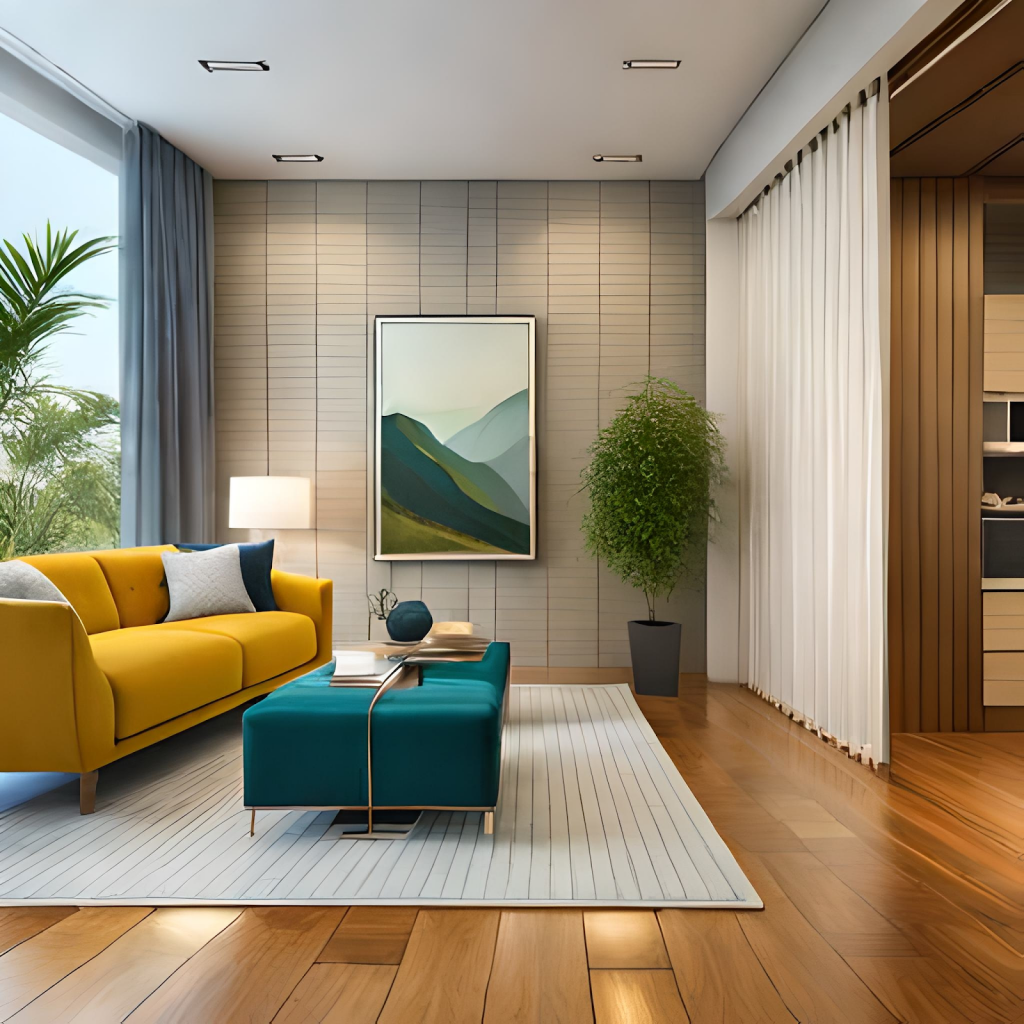Welcome to Singapore, a vibrant hub of innovative interior design that takes spaces to new heights. In this article, we invite you to embark on a captivating journey as we delve into the realm of interior design materials and their transformative power. From natural wonders to cutting-edge synthetics, Singapore offers a tapestry of materials that elevate spaces from ordinary to extraordinary.
Join us as we unravel the secrets behind selecting the right materials and explore the diverse array of options that will inspire you to create your own masterpiece. Get ready to elevate your space and unlock the true potential of interior design materials in Singapore.
What is the importance of understanding interior design materials?
Interior design materials encompass a wide range of substances, products, and elements used in the creation and enhancement of interior spaces. These materials serve both functional and aesthetic purposes in designing and decorating interiors. Examples of interior design materials include:
- Textiles: Fabrics used for curtains, upholstery, bedding, and decorative elements.
- Flooring options: Such as hardwood, carpet, tile, vinyl, or laminate.
- Wall coverings: Including paint, wallpaper, wood paneling, or decorative tiles.
- Lighting fixtures: Ranging from chandeliers and pendant lights to recessed lighting and lamps.
- Furniture: Such as chairs, tables, sofas, and shelving units.
- Accessories: Decorative items like artwork, vases, rugs, cushions, and plants.
Materials also play a vital role in establishing the ambiance and atmosphere of a space. They have the power to evoke certain moods, create visual interest, and convey specific design styles. To create the desired ambiance, interior designers consider:
- Textures: Smooth, rough, glossy, or matte finishes can influence the tactile experience and visual perception of a space.
- Colors: Different color schemes can evoke various emotions and set the tone for a room. Warm tones like red and orange create a cozy atmosphere, while cool tones like blue and green evoke calmness.
- Patterns: Incorporating patterns in materials such as wallpapers, fabrics, or tiles can add visual interest and depth to a space.
- Finishes: Materials with different finishes, such as polished, brushed, or distressed, can contribute to the overall style and aesthetic of the design.
Choosing the right materials for specific spaces holds great significance in interior design. Different areas within a building have distinct functional requirements and usage patterns, and the materials used must be appropriate for those specific needs. Considerations for choosing materials include:
- Durability: High-traffic areas require durable materials that can withstand wear and tear over time.
- Moisture resistance: Materials for kitchens, bathrooms, or areas prone to moisture should be water-resistant or easily cleaned.
- Safety: Certain materials may need to comply with safety regulations, such as fire-resistant fabrics or slip-resistant flooring.
- Maintenance: Materials that are easy to clean and maintain can save time and effort in the long run.
- Design concept: Materials should align with the overall design vision, style, and theme of the space.
- Budget: Selecting materials that fit within the allocated budget is essential for successful project execution.

Exploring the Diversity of Interior Design Materials in Singapore
Natural Materials
Singapore’s interior design scene embraces a diverse range of materials, including natural elements that add warmth and character to spaces. Natural materials commonly used in Singaporean interior material design include wood, stone, and bamboo.
Wood: What types of wood are commonly used in Singaporean interior design?
Singaporean interior design embraces the use of natural materials, adding warmth, character, and a connection to nature within spaces. Among the various natural materials, wood stands out as a popular choice due to its versatility, durability, and aesthetic appeal. Several types of wood are commonly used in Singaporean interior design, including:
- Teak: Teak wood is highly valued for its durability and natural resistance to decay and termites. It has a rich golden-brown color that deepens over time, adding warmth and elegance to interiors. Teak is often used for flooring, furniture, cabinetry, and decorative accents.
- Oak: Oak wood offers a timeless and classic appeal. It comes in different varieties, such as white oak and red oak, each with its unique grain patterns and colors. Oak is known for its strength and durability, making it suitable for furniture, flooring, and architectural elements.
- Mahogany: Mahogany wood features a rich reddish-brown hue and a smooth, lustrous finish. It is valued for its beauty and durability, often used in high-quality furniture, paneling, and cabinetry.
- Walnut: Walnut wood showcases a deep, rich brown color with distinctive grain patterns. It exudes a sense of sophistication and is commonly used for furniture, flooring, and decorative elements.
- Ash: Ash wood is known for its light color and straight grain. It is highly versatile and can be stained to mimic other wood species. Ash wood is commonly used for furniture, cabinetry, and flooring.
These are just a few examples of the types of wood commonly used in Singaporean interior design. Each type of wood carries its own unique characteristics, allowing designers to create diverse aesthetics and cater to different design styles and preferences.

Stone: How does the use of natural stone contribute to the aesthetics of a space?
The use of natural stone in interior design brings numerous benefits and contributes significantly to the aesthetics of a space. Some key ways natural stone enhances the visual appeal and ambiance of a space include:
- Elegance and Luxury: Natural stone, such as marble or granite, exudes a luxurious and timeless charm that elevates the overall aesthetics of a room. Its inherent beauty and unique patterns make it a striking feature in both residential and commercial settings.
- Texture and Depth: The natural texture of stone adds depth and character to a space, creating visual interest and a tactile experience. Whether it’s a honed finish for a sleek and contemporary look or a tumbled finish for a rustic appeal, the texture of natural stone adds another layer of visual richness.
- Versatility: Natural stone comes in a variety of colors, patterns, and finishes, allowing for endless design possibilities. It can be used as flooring, wall cladding, countertops, backsplashes, and even as decorative accents. Each type of stone carries its own distinct characteristics, giving designers the flexibility to create unique and personalized spaces.
- Durability and Longevity: Natural stone is renowned for its durability and longevity. When properly cared for, it can withstand heavy use and maintain its beauty for decades. This makes it a wise investment for interior design projects, ensuring lasting appeal and value.
The use of natural stone in Singaporean interiors brings a touch of elegance, sophistication, and timeless beauty, adding value and creating a lasting impression.
Bamboo: What unique characteristics make bamboo a popular choice in Singapore?
Bamboo, a versatile and sustainable material, has gained popularity in Singaporean interior design due to its unique characteristics. Here are some reasons why bamboo is a preferred choice:
- Sustainability: Bamboo is considered an eco-friendly material due to its rapid growth and renewable nature. It can be harvested in a relatively short time, making it an environmentally conscious choice for interior design projects in Singapore.
- Strength and Flexibility: Despite its lightweight appearance, bamboo is remarkably strong and durable. It offers structural stability and can withstand daily use, making it suitable for furniture, flooring, and even structural elements.
- Natural Aesthetics: Bamboo’s light color, distinctive grain pattern, and natural texture add a touch of warmth and natural beauty to interiors. It blends seamlessly with various design styles, from minimalist and contemporary to tropical and Asian-inspired.
- Versatility: Bamboo can be used in various applications, including flooring, furniture, wall coverings, and decorative elements like screens or blinds. Its versatility allows designers to create a cohesive and harmonious look throughout a space.
- Resilience: Bamboo is known for its resistance to moisture, insects, and warping, making it an ideal choice for Singapore’s humid climate. Its ability to withstand these challenges ensures longevity and easy maintenance.
Synthetic materials
In addition to natural materials, synthetic materials play a significant role in the diversity of interior design materials in Singapore. These materials offer versatility, durability, and innovative design options. Some commonly used synthetic materials include laminate, acrylic, and glass.
Laminate: How does laminate offer versatility and durability in design?
Laminate is a versatile material that offers a wide range of design possibilities. It consists of multiple layers of synthetic materials that are fused together under high pressure. The benefits of using laminate in interior design include:
- Versatility: Laminate can mimic the look of natural materials, such as wood or stone, at a more affordable price point. It allows designers to achieve a desired aesthetic while offering a wide range of design choices.
- Durability: Laminate is highly resistant to scratches, stains, and fading. It is easy to clean and maintain, making it suitable for high-traffic areas or spaces that require low maintenance.
- Cost-effectiveness: Laminate is a cost-effective alternative to natural materials. It offers a similar appearance without the higher price tag, making it accessible for a variety of design projects.
Acrylic: What are the benefits of using acrylic materials in modern interiors?
Acrylic is a popular synthetic material used in modern interior design in Singapore. It offers a range of benefits that contribute to the sleek and contemporary aesthetics of modern interiors. Key advantages of using acrylic materials include:
- Transparency and Clarity: Acrylic is a transparent material that can mimic the look of glass, but at a lighter weight. It offers exceptional clarity, allowing light to pass through and creating a sense of openness and spaciousness.
- Versatility: Acrylic can be easily molded into various shapes, making it suitable for custom furniture, lighting fixtures, decorative items, and even signage. It provides designers with flexibility in creating unique and innovative designs.
- Durability: Acrylic is highly durable and resistant to impact, making it suitable for high-traffic areas. It is also less prone to shattering compared to glass, offering added safety in interior spaces.
- Color Options: Acrylic materials come in a wide range of colors and finishes, including opaque, translucent, or even mirrored options. This versatility in color allows designers to add pops of vibrant hues or subtle tinted accents to complement the overall design scheme.
Glass: How does glass play a role in creating an open and spacious feel?
Glass is another synthetic material that plays a significant role in creating open and spacious interiors in Singapore. Its unique properties contribute to a sense of lightness, transparency, and connectivity within a space. Here’s how glass enhances interior design:
- Transparency: Glass allows natural light to penetrate through spaces, creating a brighter and more inviting atmosphere. Its transparency helps to visually connect different areas, making rooms feel more open and interconnected.
- Reflectivity: Glass surfaces can reflect light and mirror surrounding elements, amplifying the sense of space and adding visual depth. This reflective quality can enhance the aesthetics of a room, especially when used strategically as mirrors or glass partitions.
- Visual Separation: Glass can be used to create partitions or dividers without compromising the flow of light or visual continuity. This allows for the separation of spaces while maintaining a sense of openness and connection.
- Sleek and Modern Aesthetics: Glass carries a contemporary and sophisticated appeal, adding a touch of elegance to interiors. It can be incorporated in various forms, such as windows, doors, balustrades, or decorative glass elements, to create a sleek and modern look.
Sustainable Materials
Sustainability is a key consideration in interior design, and in Singapore, there is a growing emphasis on incorporating sustainable materials. These materials not only reduce environmental impact but also add unique character and creativity to spaces.
Recycled materials: How can recycled materials be incorporated into interior design?
Incorporating recycled materials into interior design is an effective way to reduce waste and give new life to discarded items. Examples of recycled materials that can be used include reclaimed wood, recycled glass, upcycled metal, and salvaged furniture. These materials can add a rustic or eclectic charm to a space while promoting environmental responsibility.

Eco-friendly alternatives: What sustainable options are available for eco-conscious design?
Designers in Singapore have access to a wide range of eco-friendly materials that are manufactured with a focus on reducing environmental impact. These materials include sustainable woods, such as bamboo or FSC-certified wood, low VOC (Volatile Organic Compound) paints and coatings, water-saving plumbing fixtures, energy-efficient lighting, and recycled or biodegradable textiles. Choosing these alternatives allows for a more sustainable and eco-conscious approach to interior design.
Upcycling: How can repurposed materials add character and uniqueness to a space?
Upcycling involves repurposing discarded or unused materials and transforming them into new and functional items. It offers a creative way to add character, uniqueness, and sustainability to a space. Upcycled materials can include pallet wood transformed into furniture, vintage doors turned into dining tables, or reclaimed industrial pipes repurposed as lighting fixtures. These repurposed materials not only contribute to a more sustainable design but also tell a story and create a visually appealing and personalized environment.
We can conclude
As we draw the curtain on this exploration of interior design materials in Singapore, we leave you with a lingering sense of excitement and endless possibilities. The impact of well-chosen materials on a space cannot be underestimated—it has the power to shape our moods, evoke emotions, and transform our experiences. So, dare to dream, to innovate, and to create.
Let your imagination run wild as you navigate the vast landscape of materials available in this design-savvy city. Whether you opt for the timeless allure of natural materials, the sleek elegance of synthetic wonders, or the eco-conscious charm of sustainable options, the choice is yours. Embrace the latest trends and innovations, but also trust your intuition to bring something unique to your design endeavors.
Remember, it’s not just about aesthetics; it’s about crafting spaces that resonate with your vision and speak to the soul. So go forth, elevate your space, and unleash the magic of interior design materials in the lion city of Singapore.

Design your dream house with Exqsite
20 years of professionals experience
In Exqsite, our team of 20 years of professional experience will make your house beautiful and functional in every aspect, with an eye on detail and perfection. We guarantee you will be satisfied! Here are things that you will get from us:
- We provide high-quality workmanship at reasonable prices
- We put our clients first by serving them friendly customer service
- Employees with over 20 years of experience
Make your renovation situation easier with us. Click here or visit our showroom at 8 Boon Lay Way Tradehub21 #01-18 Singapore, Singapore 609964 for the solution to your renovation problems.
Frequently Asked Question
1) What are the key factors to consider when selecting interior design materials?
Answer: When choosing interior design materials, it’s important to consider factors such as durability, maintenance requirements, and cost-effectiveness. Additionally, you should evaluate how well the materials align with the desired ambiance and aesthetic of the space.
2) What are some popular natural materials used in interior design in Singapore?
Answer: Singaporean interior design often incorporates natural materials such as wood, stone, and bamboo. These materials add warmth, texture, and a sense of organic beauty to the spaces, creating a harmonious connection with nature.
3) How do synthetic materials contribute to modern interior design in Singapore?
Answer: Synthetic materials like laminate, acrylic, and glass play a significant role in modern interior design in Singapore. They offer versatility, durability, and a wide range of design options. These materials can create sleek and contemporary looks, enhance natural light, and contribute to a sense of openness in spaces.
4) What sustainable materials are available for eco-conscious interior design in Singapore?
Answer: Singapore offers various sustainable materials for eco-conscious interior design. Recycled materials, such as reclaimed wood or repurposed metals, can be incorporated into designs. Additionally, eco-friendly alternatives like bamboo flooring, low VOC (volatile organic compound) paints, and recycled glass countertops are popular choices.
5) How can incorporating smart materials enhance interior design in Singapore?
Answer: Smart materials, with their integration of technology and design, can revolutionize interior spaces in Singapore. They offer innovative functionalities like self-adjusting lighting, temperature control, and sound insulation. These materials create a seamless and interactive experience, elevating the overall ambiance and convenience of the space.

